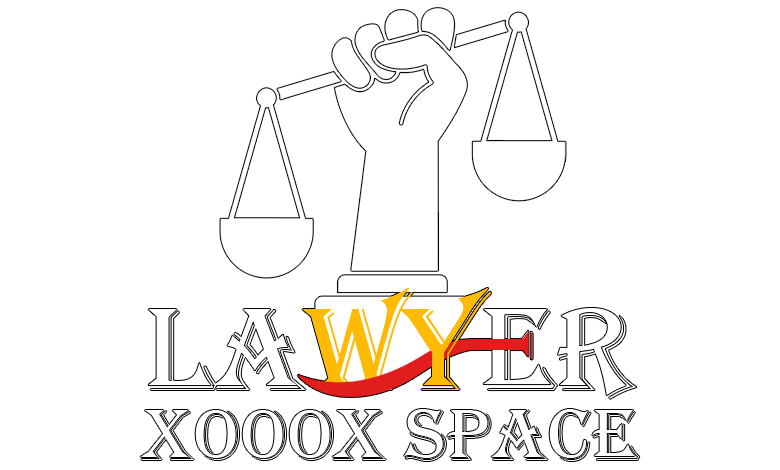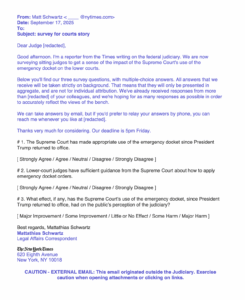Do federal judges believe we are in the middle of a “judicial crisis”?

Today New York Times reports that some federal judges are unhappy with the Supreme Court’s repeated granting of interim relief to the Trump administration in cases challenging the administration’s actions.
More than three dozen federal judges told The New York Times that the Supreme Court’s wave of brief and opaque emergency orders in cases related to the Trump administration has left them confused about how to proceed in the cases and is hurting the judiciary’s public image. . . .
The striking and highly unusual critique of the nation’s highest court by lower court judges reveals the extent to which litigation over Mr. Trump’s agenda has created tension in the federal court system.
The story is based on Times‘Selective survey of federal judges. This is how the Times summarizes his results.
Sixty-five judges responded to a Times questionnaire sent to hundreds of federal judges across the country. Among them, 47 said the Supreme Court had mishandled its emergency case since Mr. Trump returned to office. . . .
In interviews, federal judges called the Supreme Court’s emergency orders “mystical,” “too brutal,” “incredibly demoralizing and troubling” and “a slap in the face to district courts.” One judge likened his district’s current relationship with the Supreme Court to “a war zone.” Another said the courts were in the midst of a “judicial crisis.” . . .
Forty-two The justices went so far as to say that the Supreme Court’s emergency orders had caused “certain” or “major” harm to the public’s perception of the justice system. Among those who responded to the question, nearly half of Republican-appointed judges said they believed the orders had damaged the judiciary’s reputation in the public eye.
Twelve judges who responded to the questionnaire said they believed the Supreme Court had handled its emergency docket appropriately. But only two said the public’s perception of judges had improved because of the way the Supreme Court had handled its recent work.
THE Times presents his analysis as “the most comprehensive picture to date of the extraordinary tensions within the justice system.” But is it really so complete? According to history, the Times « contacted more than 400 the judges, including all judges in districts that have handled at least one legal challenge to a major element of Mr. Trump’s agenda” (emphasis added). In other words, the Times did not seek a random or representative sample of federal judges, but rather sought a sample weighted in favor of judges most likely to disagree with the Supreme Court. (Update: Times the story would have had the same impact if it had reported”Fewer than fifteen percent of federal judges surveyed expressed concerns about how the Supreme Court has handled the shadow docket.“? Of course not, but it would be a true statement of what the Times found, even with the non-representative sample.)
As I have noted in previous articles (and this test for The dispatch), lawsuits challenging the Trump administration’s initiatives are not randomly distributed among the country’s judicial districts. Rather, they have been concentrated in districts where plaintiffs expect to be most supportive of their claims. So, by ensuring that every judge in these districts is included in his investigation, the Times oversampled the justices most likely to disagree with the Court’s handling of the Trump administration’s requests for interim relief. After all, judges tend to think their decisions were correct.
Even with oversampling, the Times got only sixty-five responses, and we have little information about the extent to which these judges are representative of the respondents, let alone the federal judiciary as a whole (especially if, as history suggests at one point, some of the respondents are high-ranking judges). THE Times provides a breakdown of the number of responding judges appointed by Democratic and Republican presidents (and President Trump in particular).
Of the judges who responded, 28 were appointed by Republican presidents, including 10 by Mr. Trump; 37 were nominated by Democrats. While justices appointed by Democrats have been more critical of the Supreme Court, justices appointed by presidents of both parties have expressed concerns.
It’s interesting, but it doesn’t tell us much.
Given the norms that have long prevailed for district court appointments (including compliance with blue slips), the party of the president who appoints him tells us much less about a district court judge than it does about appellate judges. Such norms may be breaking down, but until recently it was rare for a district court judge to be appointed without the support (or at least acquiescence) of the home state senators, and political deals were common. As a result, the party affiliation of a state’s senatorial delegation has long been a better indicator of a district court judge’s likely judicial ideology than the party of the president who nominated him or her.
Although the article cites a handful of judges willing to provide feedback to the Times journalists, the supposedly “complete” picture comes from the responses to Times‘ brief investigation – responses to the investigation which could be inappropriate with regard to the canons of judicial ethics. Like the Times Remarks :
The justices responded to the questionnaire and spoke in interviews on condition of anonymity so they could candidly share their views, because lower court judges are governed by a complex set of rules that include limits on their public statements. . . .
The code of conduct for federal judges requires that they act in a manner that promotes “public confidence in the integrity and impartiality of the judiciary.” They rarely comment on public controversies and almost never share their views on Supreme Court jurisprudence, outside of the carefully chosen terms of their written opinions.
Given the potential ethical concerns of speaking to the press about these issues, it may also be the case that the justices most likely to respond to the survey are also the most unhappy or critical of the Supreme Court. If this is the case, this would be another reason to doubt that the feelings of Times the reports are vaguely representative.
Finally, we can ask ourselves if the Times The survey was designed to obtain particularly substantive or nuanced information. I have a copy of what Times emailed at least some of the respondents. (Screenshot below.) Here are the questions asked:
- The Supreme Court has made appropriate use of urgency since President Trump returned to office.
(Strongly Agree / Agree / Neutral / Disagree / Strongly Disagree)- Lower court judges have ample guidance from the Supreme Court on how to enforce emergency orders.
(Strongly Agree / Agree / Neutral / Disagree / Strongly Disagree)- What effect, if any, has the Supreme Court’s use of the emergency docket, since President Trump’s return to office, had on the public’s perception of the justice system?
(Major improvement / Some improvements / Little or no effect / Some harm / Major harm)
THE Times The story ends with comments that appear to come from an interview with J. Harvie Wilkinson of the U.S. Court of Appeals for the Fourth Circuit.
Some justices have been more equivocal about the emergency orders, views echoed by Judge J. Harvie Wilkinson III of the U.S. Court of Appeals for the Fourth Circuit, a highly respected legal scholar and Reagan nominee who wrote a strong role defense that district courts play in the constitutional system. In an interview, Justice Wilkinson noted that the Supreme Court was largely at the mercy of circumstances beyond its control: a large number of emergency challenges to a presidency that would “put its foot on the pedal, because it has an agenda and it is sensitive to the fact that electoral mandates are perishable.”
While noting that the emergency role had its advantages in terms of quickly and uniformly handling a growing workload from the executive branch, Justice Wilkinson said there was a good case for the Supreme Court to be careful not to overuse it.
“You don’t want too many hasty judgments and emergency orders to create a public impression of secrecy or arbitrariness,” he said.
Screenshot from the New York Times’ investigation of a federal judge:





